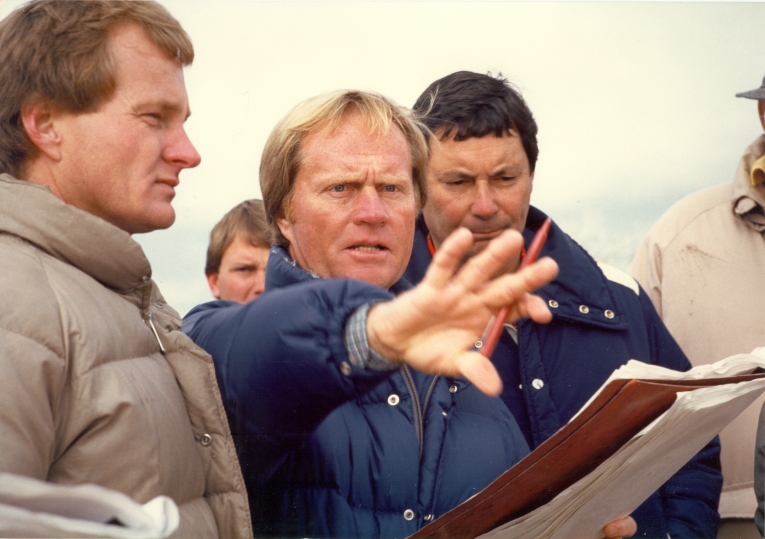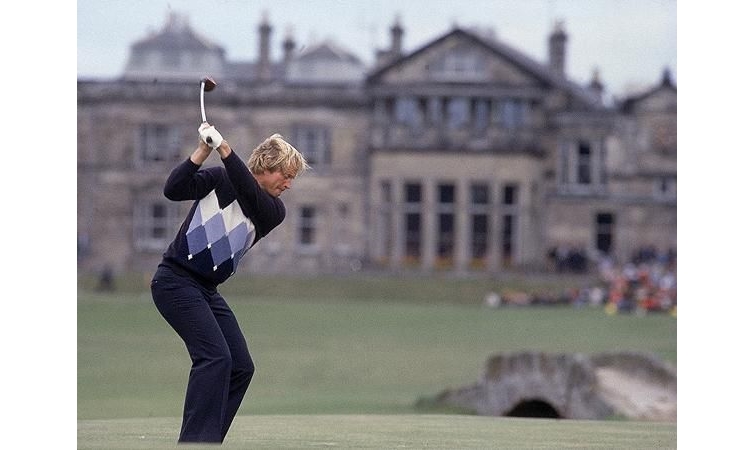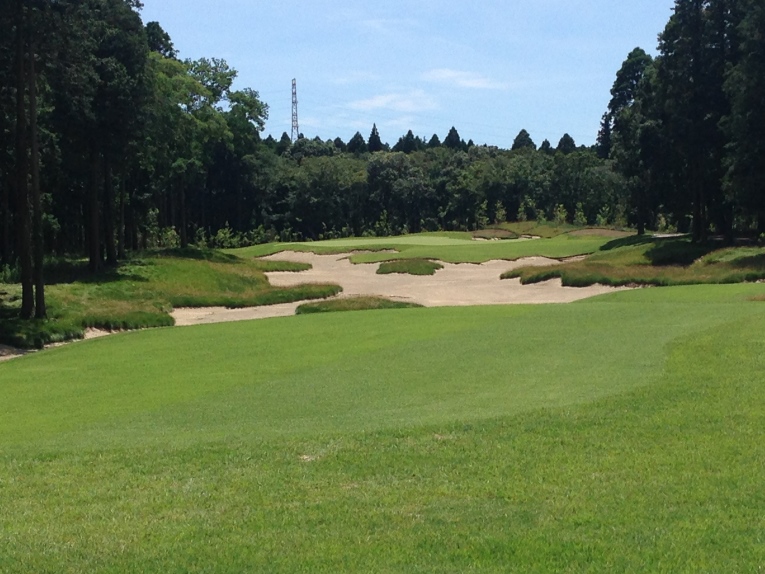Feature Interview with Jack Nicklaus
August 2015
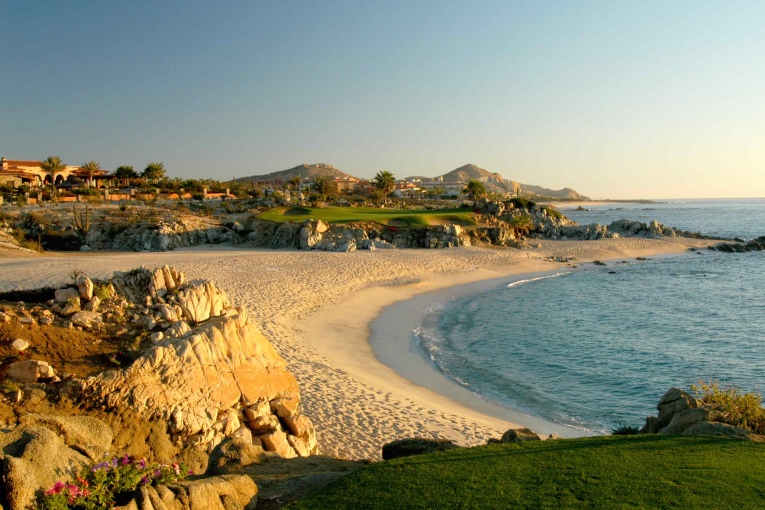
Nicklaus Design has worked in forty-one countries. Above is the famed seventeenth hole at Cabo del Sol in Mexico. (Photo courtesy of Jim Mandeville)
What sparked your initial fascination in golf course architecture? After all, world events were grim in the 1940s. In the 1950s and 60s, Golden Age designs were underappreciated and/or being modified and there were more misses than hits in new course design.
You would have to trace it back to when Pete Dye asked me to come out to The Golf Club in Columbus and look at what he was doing with the design. That was in the mid-60s, maybe 1966 or ’67. I remember one hole where he had designed a big round green with four round bunkers. We agreed it didn’t look very good, so he asked for my ideas and Pete ended up using them. He started asking me more questions. I had no idea that he would ever use any, nor did I have an idea that I was contributing. I found the whole experience a lot of fun, and I was very flattered that he used some of my ideas. Not long after, he asked, “Would you like to consult with me?” I told him I would be delighted to work with him. Shortly thereafter, we collaborated on Harbour Town, which was one of four courses we co-designed in about a three-year period from 1969 to ’72.
Among the reasons I got involved in golf course design at a fairly young age, was because it was something else that kept me in the game and challenged me. Golf was always a vehicle to competition for me, and course design is no different. It has always been me against a piece of ground or my own creative abilities. But for about 10 or 12 years it was kind of a hobby. An expensive one, as it turned out, so then I turned it into a business. As the gentleman who ran our company at the time said, ‘Jack, it’s time to turn your avocation into a vocation.’ I’m proud to say it’s been a very healthy business decision.
What did you learn from Pete Dye?
I like Pete Dye. Pete and I played a lot of amateur golf together. We were good friends and remain good friends. In fact, we spoke not long ago. The one thing I learned that never entered my mind prior to working with Pete is that golf is a far more pleasant game when played downhill. And, when you’re playing downhill, you see more of what’s in front of you. So, that’s sort of one of the philosophies I have used over time. Whenever it’s possible, I try to have my tee above my landing area and my landing area above my green. I always think that playing from slope to counter-slope is always much more pleasant than playing over a convex surface. It is much more definable. I think Pete has always had a little bit of that, and I learned from him. As far as how the golf course played and what we’ve done, Pete and I have a lot of the same ideas, but we have a lot of different ideas, too. I have mine and Pete has his.
Does a specific example come to mind on where you and Pete Dye differed?
As I suggested, Pete was interested in keeping it an avocation, and after a while, I figured I couldn’t afford that. I was in my late 20s or early 30s. I couldn’t afford to approach design much like a hobby. For the first few years, I had to at least cover my expenses, which we did, and then finally, in about another 10 years, I really made it a vocation. A lot of Pete’s philosophies are ones that inspired me and ones I agreed with—and still do today—but naturally, we have a few design differences. Pete likes to play alongside things more than I do, and I like to play across things more. For example, he likes to have water hazards right down the line of the side of the hole, a la 18 at TPC. Perhaps by comparison, both Holes 11 and 5 at Muirfield Village Golf Club are carries. I prefer that more than Pete does.
Charles Fraser went to Mark McCormack wanting a ‘name’ for building Harbour Town. He brought you in, and then you brought in Pete?
That’s right; I enlisted Pete for his help at Harbour Town as I really had no idea what to do with a golf course at that time. But I made 23 visits to Harbour Town. I learned a lot from Pete, and I had a great time. Alice was there some and she got involved a little bit. We were both learning.
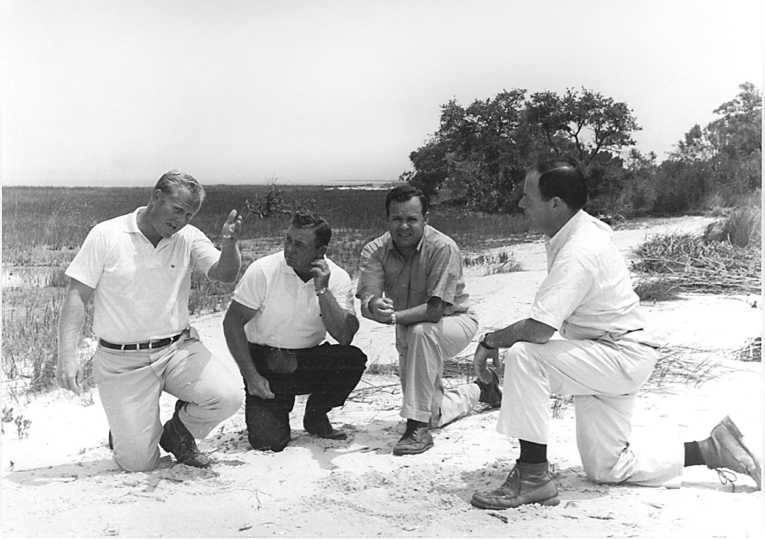
Nicklaus, Donald O’Quinn, Charles Fraser and Pete Dye at Harbour Town, pre-construction. (Courtesy of the Nicklaus Archives)
There’s a funny story about your fee and the money paid?
We charged a $40,000 fee. I think that’s what it was. We charged $40,000 back then, and Pete took every bit of that and put it back into the golf course. In other words, I never made a dime off any golf course I ever did with Pete. But that was alright. I wasn’t expecting to do that; I was there for the learning experience. It was a great experience and you can’t put a price on that. I love working with Pete. He’s a great guy, and a great person from which to learn.
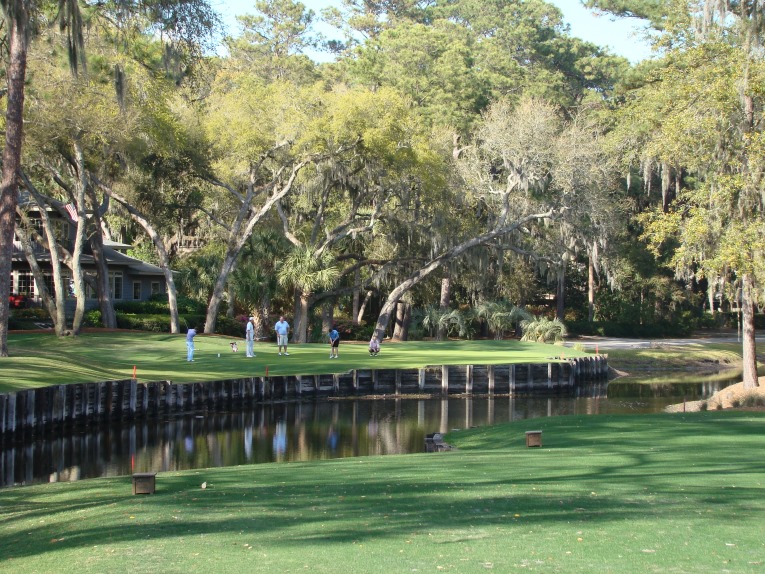
Harbour Town measured under 6,700 yards when it opened and set a new standard for interesting targets. Above is the one shot 14th. It measured 152 yards when Nicklaus fired a course record 63 in 1975. It measures 192 yards today to accommodate for changes in the ball.
I love that story as it highlights that money wasn’t what drove Pete. From the start, Nicklaus Design has designed strategic golf courses. Where did you develop your concepts for strategy? How did your own playing style and the way that you envision golf shots influence your designs? Did Jack Grout play a role?
When I first started, I did courses in my own image of how I played. I found very quickly that everybody would say, “Oh, Nicklaus was here—it’s left to right.” So obviously I changed that. I went back and tried to balance my golf courses. I learned how to balance my golf courses with different directions, with par 3s, 5s, 4s, rights, lefts, etcetera. I used what I had learned from playing golf, from watching average golfers, from watching women play, and tried to incorporate that into a game and a strategy that would fit all people.
As for Jack Grout, he did not influence my design. He influenced me in many other ways, because he was a wonderful teacher, mentor and second father to me. But he did not influence me on the course design side. I developed early design concepts from the holes I played and appreciated from around the world. It was not necessarily from people.
Thought provoking par 5’s have come easy for you. One of my favorites is the 15th at May River with its Spectacle bunkers short of the reachable par 5 green. To your point above, is that an example whereby your time at Carnoustie inspired that design concept?
Maybe in concept, but not necessarily. I just sort of like that. I have never thought about it, but Carnoustie may have influenced it a little bit.

Carrying in two these Spectacle bunkers twenty yards short of the fifteenth green is wildly satisfying and has the golfer practically jogging up the fairway to see if a short eagle putt awaits.
And how about the 3rd at Cabo del Sol? It certainly enjoys many of the wonderfully infuriating playing qualities of the 10th at Riviera.
I love the 10th hole at Riviera. It has so many options. I use that, and variations of that, in theory and strategy many times. I love shortish par 4s.

The angled 3rd green at Cabo is open in front and can be reached from the tee under certain conditions. The greedy golfer can also get woefully out of position!
As a player, was there a well known hole that confounded you, one that you did not particularly enjoy playing?
You might say the fifth at Colonial. I always thought that was a really difficult hole, with the water on the right and being a dogleg right. Any shot to the left and you had nothing to play against, because you had a swale on the left that threw the ball left. It was a really difficult hole to put the ball in the right position to play your second shot. I admired the hole for its difficulty, but the way it was configured … I always thought one side of a hole should be playable; there should be some way to play it. Here, you just had to be spot on and perfect. But, I don’t think golf is a perfect game. I didn’t dislike it, but I thought it was difficult. Having said that, one of the philosophies I always took into a tournament, and certainly a major, was that the golf course—or golf hole—didn’t have to suit you and your game. Your game has to suit the golf course.
Are all of your golf courses collaborations? Put another way, do you give latitude to your on site design team and staff, which leads to a collaborative effort?
I do have designers and a production staff that assist me with some of the fundamental, basic work—most of what needs to be done on computer for the client, permitting, approvals, construction, etc. In fact, all our design staffers do routings. But I make the final decision on the routing. The golf course routing, the strategy, the look, how the course plays, and what is on top of the ground has always been mine and remains mine — 100 percent. That is my responsibility and what I enjoy most.
But if I have a design associate who’s got good common sense and he’s got a good idea, I am certainly going to listen. You should never be closed to a good idea. If that means collaboration, yes. I am very proud that we have 24 past and present designers who have gone on to earn their membership into the American Society of Golf Course Architects. Many have gone on to build their own businesses and reputation, which says a lot about the legacy we have created at Nicklaus Design and the work we do together in the field and in the office.
We also have a number of current designers who have been with me for 20 to 30 years. I consider them extensions of what I like to do in the field and what I think makes for a good golf experience. And when together in the field, we constantly bounce things off each other. The same goes with those who represent the owner or developer. Your better golf courses are not only a collaboration with your team, but also a collaboration with your owner, and whatever your owner wants, and whatever you’re trying to accommodate.
Have I done a design that’s solely for me? No, hardly ever. And, even clubs that I’ve done for “me”—meaning I have some kind of ownership tie, such as Muirfield Village Golf Club and The Bear’s Club—I have continued to modify them to make sure my membership can play the golf course. So, you want to do golf courses that are for everybody—not just for the big hitter, not just for the great player. The game is for everybody—young and old, beginner or very accomplished—and your design should follow.
You have to have variety, you have to have imagination, and you have to be able to adjust with the times, and that’s what we’ve tried to do.
Is there a specific way you go about tackling the routing process? For instance, some claim that Colt would first locate ideal par 3s and then fan holes out from those points. Complicating matters for you is bound to be the residential component, something with which Colt largely did not have to contend.
Most golf courses that we have done, real estate has not been part of the routing process. When you’re talking about a project that includes residential, most of the housing is situated in the high areas of the property, and I’ve always felt golf was best played through the valleys. I don’t think housing has ever bothered me from that standpoint, but we’ve generally laid it out and had corridors wide enough so that the residential didn’t affect the golf. It’s never been something with which I had to contend. I didn’t think it was a big issue.
Interestingly, you reference Colt and his philosophy. Whenever I do a golf course, I tend to connect the golf course or connect golf holes with par-3s, rather than start with the par-3s.
I attended the 1996 Australian Open held at The Australian Golf Club. You implied then that you would like another go at your work there. How would Nicklaus Design tackle that work at the Australian GC compared to how it was done four decades ago?
I’ve done them both. I did it four decades ago, and today.
Oh, I didn’t realize that you had been back.
Yes. What did we do? Back in the 1970s, Kerry Packer was the one who led the first redesign and brought me in. Kerry Packer wanted the golf course to look as much like Muirfield Village as it could. He loved the club and course. He had a villa there and came to America quite often to play Muirfield Village. He was one of my original members. Kerry loved Muirfield Village. When we did The Australian Golf Club, he wanted it to look like Muirfield so we did bunkers and some other elements like we did there.
When we came back and the membership wanted to redo the golf course 40 years later, the membership said, “What do you think should fit here?” I said, “I think you’ve got a sandy piece of property. It should be a little bit more of a natural look. The bunkers should be a little bit more natural.” And that’s what we did, without destroying the quality of the golf course that was there originally. We just enhanced it.
It was the only membership I’ve ever gone to that said they wanted to make the golf course more difficult. I said, “You really don’t mean that, do you?” And they said, “Oh yes we do!” I kidded with them, calling them The Australian Golf Club masochists—facetiously, of course.
Your early 1980s designs are associated with both difficulty and strategy. The word “fun” inserts itself into your later works like May River and Cabo del Sol. How do you analyze your evolution as an architect?
When I first started doing golf courses, almost every golf course that I was hired to do was for an owner who was looking to one day host a tournament there. Even when I collaborated with Desmond Muirhead for Muirfield Village, it was that way. Actually, even before that, when I think of my King’s Island course, which is a public golf course that opened around 1973—or a year or so before Muirfield Village. It hosted the King’s Island Open for many years. We had King’s Island, Glen Abbey, Shoal Creek, Annandale, Castle Pines—those were all golf courses that I did in my early years that lent themselves to tournament play. So, if you look back to the first five to 10 years of my design career, that’s what I was asked to do probably 75-80% of the time. That was my job.
My job certainly was not to appeal to my ego. Owners and developers wanted to have tournament golf, but as you do that, you look at it and say, “Hey, somebody else is going to play this golf course besides the tournament once a year. There are members and guests who are going to play this course the other 51 weeks of the year.” I’ve adjusted Muirfield Village for 40 years, trying to make sure that the membership has fun, and that the course is user friendly and playable. As you go on, and you start to redesign some of your original designs, you learn how to incorporate those changes within new golf course designs. It’s not that hard to do. It’s an evolution for anybody. It’s common sense.
You have certainly worked across diverse landscapes, from the desert to the ocean. Given its sandy soil, wild topography and wind, does Dismal River rank among the best, most feature rich raw sites that you have been given?
The original design at Dismal River reflects probably the least amount of dirt that I have ever moved on a golf course. Basically, we did zero. Often times irrigation was put in after the prairie was mowed down before a yard of dirt was moved. The greens were located and put exactly right on the ground that was there. We simply softened any feature in them to get pinnable pitches in them. The only dirt we moved at Dismal River was on the par-3 15th hole. There was a little nose of a hill that stuck out that blinded a par-3 from where I wanted to put the tees. We knocked that nose off—maybe a thousand yards worth of dirt is what we knocked off. We never shaped it to anything; we just knocked it off. That’s all the dirt we moved.
What brought about the redesign of a few holes some years later there?
After we finished the golf course and people played it for a while, some said the greens were too tough. The greens were what they were, but I didn’t want to change them, because if somebody was going to travel three or four hours in a car to get to Dismal River, why would they do that and leave their course in Denver, or Minneapolis, or Omaha, or wherever it might be, to play something they have at home. So, my feeling was that the golf course should be totally different than anything they’ve seen. If you want to talk about a minimalist golf course, that’s the most minimalist golf course you can possibly do.
Pronghorn in Oregon was also a minimalist golf course. Pronghorn was constructed totally on top of lava; we found our site from there. The only dirt that was moved at Pronghorn—was to shape the green complexes and build a lake for irrigation. But that’s it. The rest of it was totally there. There was less than 60,000 yards of dirt moved on the whole golf course, and over half of that was for the lake.
What brought us to change Dismal River was that the new owner wanted to change the golf course, because he thought it was too tough. That’s fine. It’s not my golf course; my job was and always is to do what the owner wants. So we changed a few things, moved a couple of greens. Did I think that was necessary? Not really. Is it still a good golf course? Absolutely.
Just to circle back, what are some of your favorite raw sites? Is Dismal River one of them?
I’ve had a lot of sites that have been very good. Dismal River is a terrific site. Is it the best? It’s certainly one of them. I mentioned Pronghorn, which I thought was terrific. I thought Muirfield Village was terrific. I thought St. Francis Bay in South Africa was terrific. There are a lot of golf courses that we’ve done that are just naturally good sites. Closer to home, look at a course such as Governors Club in Chapel Hill, North Carolina. That site was very natural and we didn’t move hardly anything there. We’ve done a lot of golf courses, which are really natural and natural-looking golf courses, and we didn’t have to do much to them. But, then again, if you’re going to do it totally that way — like we did at Dismal River — that is ok.
I think we have to be careful at times when labeling people minimalists. You can’t confuse a look with actual minimalism. My feeling is that minimalism is finding a golf course and utilizing the property almost 100 percent, as we did at Dismal River. We moved virtually zero dirt at Dismal River and in the end, unfortunately got much criticism because the greens were too severe. The greens were what was there. That was minimalist. I was then asked to adjust the greens and that, to me, was still minimalistic but it definitely required moving some dirt. I’ve seen many of the guys call themselves minimalists, yet they have moved a great deal of dirt to create the look of a minimalistic golf course. I’ve done many, many golf courses that are far more minimalistic than what some of the minimalists do. On other occasions where it is necessary to move dirt to create a golf course, that’s OK. Because your objective is not to make sure that you don’t move any dirt; the objective is to produce a good golf course for your client. Sometimes you can find it and sometimes you have to create it, or a combination thereof.

Dismal River highlight that courses rooted in nature are always the best. (Photo courtesy of Jim Mandville)
Many of your courses like Valhalla, PGA National and Muirfield Village host professional events that are fun to watch on television. They feature do or die shots that give even the best of the best white knuckle moments. How do you balance the tournament challenge with the need for a course to be fun the other 51 weeks of the year?
You figure that the average golfer is not supposed to hit the ball as far as the pro is supposed to hit it. And, you always try to figure out an alternate way to play the golf course. If you look at most every golf course I might have, occasionally, a hole where there’s no bail-out. But very rarely do I do a golf course where you don’t have a way for the women, seniors, or the average golfer to play the golf course. Very rarely do I have any holes that don’t present you an alternative or areas where you can bail out.
If you go look at The Bear’s Club, which has 25 touring professionals who are members of the golf course, they think it’s a wonderful golf course to play. I think every green is open. You can run the ball on to every green on the golf course. I have a bailout on every single hole, but it doesn’t affect how they play. That’s the evolution of my design. And even though The Bear’s Club is a strong golf course, the members love it.
You have always been both passionate and conversant about golf course architecture. Is it a subject that stimulates genuine interest on tour?
Not necessarily. I don’t recall ever really talking to any of them about it. I mean, every once in a while, someone will ask, “Jack what were you thinking here? What did you do here? And why did you do that?” I get that occasionally, sure. And I just tell them what I thought at the time.
You designed six courses at Desert Mountain. Did you have concerns that they would look the same? How did you instill variety while still being true to the landscape?
Well, I did. Creating variety within one community or complex was very important to us. We started at Renegade. That was a golf course that Lyle Anderson wanted to try using two pins on each green. We are now redoing Renegade ourselves next year, and I’m going to change a little bit of that, but it will still have two pins. As a matter of fact, I even had one green where we had three. We put in three pins on one hole, and I may do that once or twice. Anyway, that was Lyle’s philosophy, and it was a big golf course, and it fit very well into the desert landscape. That’s what it was.
The second two courses we did there were Geronimo and Cochise, which was a golf park—in other words there are no houses within the golf course. One was intended to be a fun, sporty golf course, and that was Cochise. It turned out that Cochise has hosted a lot of events. Cochise was not designed to be the tournament golf course, but it was one people could move around very easily. It was the friendliest piece of property. Geronimo was a rugged piece of property—a stronger golf course, but hard to walk around if you wanted to have a gallery. So, all three of those had a different look.
We then did Apache, and I finally said, “Let’s take this linear piece of property, and let’s not move much dirt. Let’s try to shape a course into what’s there.” That gave Apache a different look and a different way it played.
Then we did Chiricahua, which was up into the side of the hills. Chiricahua actually had a lot of forced carries, because you had big canyons and you didn’t have an option. Chiricahua is a totally different looking golf course and it plays differently. We changed the bunkering on every golf course to be a little different.
The last golf course was Outlaw, which again, was a piece of property on the top of a knob. We basically moved almost no dirt whatsoever, and tried to put the golf course 100 percent into what was there—much more so than even Apache. Actually, with Apache we used the land, but we constructed everything that we played in. But with Outlaw, we left everything alone and put the golf course on top of it. And, also in the first 10 years, they didn’t overseed Outlaw. That created a different look, as well.
Every golf course had a different look and every golf course had a different way it played. In other words, with any one of the six, in my opinion, no one could say “I played that hole, and it looked kind of like a hole on another course here.” They’re all different.
What do you make of the evolution of Augusta National over the 50 years you have played there? You experienced it then when it was wide open with slower greens and ragged bunkers, as well as today’s narrower version with blazingly quick greens and an immaculate presentation.
The greens were pretty quick back in the old days, only because of the pitch on the greens. The greens are the same greens they always were. Because of the upright grass today, they can create the speeds, but before, the grass was overseeded and it would lie down the slopes. You never would be able to stop a ball going down the slopes, because there was nothing to stop it. Today’s grasses allow the ball to stop. You can have faster speeds, because you can obviously have an end to your putt. But in those days, you couldn’t, even though they didn’t have the overall speed. They had the slope speed. But the greens haven’t changed a whole lot; they’ve actually been eased a little bit. The greens have eased a little bit because of speed.
We (Nicklaus Design) redid the 9th and 18th greens, which used to be 11 or 12 percent, and are now 8 percent. We changed Hole 14, and we redid a couple of other things on the greens. But you know, the golf course is the only golf course I know that has had the funds available to be able to try to make the golf course play in 2015 similar to what it played in 1975, let’s just say. They have changed the length of the golf course and some other things for the professionals and these changes have made it a little bit more difficult for the members. But, it’s really not a changed golf course.
They’ve added lots of trees, and they’ve added rough. I don’t care for the rough—I’d much prefer to see a ball run out and into the trees. I thought that was a unique part of the golf course that Bob Jones liked and wanted. But they’ve separated the holes from the trees. The trees are the biggest difference. The bunkers are essentially the same. They’ve been moved a little bit but not much.
Some suggest the way that Augusta played in 1986 (!) was the pinnacle of strategic design. Thoughts?
They’ve done a good job of having the golf course play relatively the same today as it did 50 years ago. They’ve done a really good job. Does it play the same? No. But it does play relatively the same.
You are too modest – that Sunday highlighted how great architecture both stimulates and rewards great play! Here are two photos of the 4th hole at Augusta. Any preference?
I don’t feel strongly about either one. I think you answer the question by asking, “What are you trying to achieve?” Are you trying to achieve the manicured, clean look, all-rye grass, and not have brown edges and so forth—the look that Augusta tries to achieve? Or are you trying to create something that looks more free-flowing, a little bit more like what Alister MacKenzie originally started to do, but probably is impractical to maintain today the way they like it? I have always liked the general style of free-formed, random-looking bunkers, but it comes down to what the club is trying to achieve.
Is it accurate to suggest that Augusta National influenced your design at Muirfield Village? Are there other courses whose style features or strategy have most impacted your work?
Anybody who played as much tournament golf as I did would be influenced by Augusta National, and influenced by Bob Jones and his philosophy. They would also be influenced by St. Andrews. I think those are the two biggest influences that I had. Both Augusta and St. Andrews are second-shot golf courses and I always preferred second-shot golf courses because most people like to hit a driver and have fun with it. But, if you put the drive on the wrong side of the golf course, you should have a more difficult approach. If you put the driver on the proper side of the fairway, you should have an easier approach. That was Jones’s philosophy and it’s a good one. I like it, and I’ve used it in a majority of my styles. The only difference today is that because of the golf ball, you need to take the driver out of somebody’s hands three or four times a round to balance or even the playing field.
Speaking of The Old Course, this year marks the 45th anniversary of your Open Championship victory at St. Andrews. How did The Old Course play in 1970? For instance, what were the green speeds that year?
I don’t know whether they ever measured green speeds, but the British Open never seemed to feature fast greens. I don’t believe they are fast greens today. The British Open was always played, at my guess, with green speeds around 10 to 11.5. That’s about what the greens were, and they’ve seemingly been that way forever—no matter the course you played. They’ve never been extremely slow either, though Royal Birkdale had a couple years where they were a little slow. But for the most part, the greens speed has been 10-ish, plus, and I don’t think that the greens ever got much over 11-ish. They’ve been pretty consistent over the years.
St. Andrews, when I played it in 1964 and 1970, it really hasn’t changed much. The only thing that’s happened is there have been a few tees added to accommodate some of the length of the golf ball. But, outside of that, St. Andrews has pretty much remained as it was.
Do you prefer the cleaner, sharper look of the Old Course today, or the more varied one from decades past?
I never really paid attention to whether the bunkers were clean or rugged though the look of St. Andrew’s is one I have always liked. In fact, I fell in love with St. Andrews from the day I stepped foot there. But when I was playing in the British Open, I was focused on trying to win the Open—not so much on bunker maintenance. For the most part, there was a very large percentage of revetted bunkers. Perhaps all were. Some were in disrepair, and some were always clean. In recent years, they’ve been very clean. There were likely bunkers that had the look of a blowout, yet were revetted at the far end. Maybe I am wrong, but I think all the British Open courses had revetted bunkers, but I’m just not sure.
As for look of the bunkers, that revolves around what do they want to have for the British Open? Do they want to be consistent? What do they want to be? I could go either way.
Several significant changes were made to the Old Course in 2012. Martin Hawtree carried out the work as directed by the Royal & Ancient. Tom Doak and other architects urged the Royal & Ancient not to pursue such work. Did you have an opinion then or do you now?
Well, I would like to have not seen any changes on the Old Course. The only change I wanted to see was a change to the golf ball. The only reasons they (R&A) felt changes were needed to the Old Course is because there were changes to the golf ball. If you hadn’t changed the golf ball, you wouldn’t have had to change Augusta National, or you wouldn’t have had to change St. Andrews, or any golf course — iconic or not— if we could get the golf ball to go the proper distance again. Until they change the golf ball, championship golf courses have to fit the ball of today.
Regarding Doak, what was the give and take like working on Sebonack together?
I would say that the routing for Sebonack was largely Tom, and the strategy was largely me. The decision-making was something we had to agree upon, otherwise the owner, Michael Pascucci, would make the decision. We never wanted the owner to make the decision (says smiling). The only thing the owner decided was he wanted a par-5 for the finishing hole, which we did. Pascucci was a very good owner. He let us do the golf course. I think I had more control of tee to green, and Tom had more control of the greens themselves.
You fell in love with links golf but the ground game seems almost dead in America. Is it simply an issue of climate in that only a handful of places in North America (the Pacific Northwest, Nova Scotia) can have all fescue courses, or is the divide between Great Britain and American golf so pronounced for other reasons?
I don’t think weather and climate are big issues. We have a few golf courses out on Long Island, we have a couple golf courses up through the northeast that would fall into the British, links-style standards. There may be some in the Pacific Northwest that are fescue courses. I don’t think you have fescue golf courses in Britain anymore. Even the seaside golf courses in Britain have added varieties of grasses into the fairways. A lot of them aren’t fescue anymore, although some still are. Most of them are a mixture of whatever happened to grow there. Seaside golf is, generally speaking, dictated by the soil conditions. Granted, we do sand-cap today and we can make soil conditions much firmer, and we try to do that wherever we can, because I much prefer a fast course to a slow course. I don’t like slow golf. I never have.
However, if you made every golf course the same, we wouldn’t have variety. And if you had every American golf course looking like a Scottish golf course, and every Scottish golf course trying to look like an American golf course, what are we going to end up with? Why don’t we have Scotland look like Scotland, and America look like America?
Great point! You once famously took off your sweater and proceeded to smash the tee ball over the last green at St. Andrews. Apart from that moment, I don’t readily recall you facing many drivable par 4s in the 1960s through early 80s. Now, every design seems to have at least one. What is your opinion on such holes? You’ve built some great short par 4s, for example, 14 at Muirfield Village, 8 at Concession, 7 at May River—none of which are drivable.
Oh yeah, I feel they are. Certainly the 14th at Muirfield Village.
Well, to quote Bob Jones, ‘You play a game with which I am not familiar!’
You can’t drive No. 8 at Concession. But anyway, I like short par 4s and I’ve got a lot of them that are drivable. I like to have one or two on a golf course if possible or under certain conditions, or use a variety of pin placements that could be drivable. It’s a fun part of the game. I don’t think it’s a necessary part of a golf course, but it’s a fun way to have it. The pros today drive the 14th hole at Muirfield Village, and 40 years ago, I used to go out to the front tee and practice driving it on that hole with a narrow fairway and a creek on the right approaching the green as preparation for the US Open. It used to be one of my favorite places to practice. I used to drive the ball into the fairway or right up onto the green. I did that every year with Jack Grout. There are times and places I think it’s appropriate.
In 1964, the first time I played at St Andrews, the 18th hole we played from a longer tee than they play today. I drove it onto the green all four rounds. The first round with a driver, the last three rounds with a 3-wood—and that was in 1964. Then in 1970, I drove it over the 18th green at St. Andrews in a playoff. In 1978, I don’t believe I ever reached it. We went to the big ball by that time. But, you always had a couple of greens at St Andrews that were possible to reach. You always had a good shot of getting it close at 7; you could drive the ball at 9; and you could drive the ball at 10 onto the green on both occasions, if the wind conditions were correct. You could drive it on 12, if the wind conditions were correct. St Andrews had a lot of drivable holes.

Nicklaus Design has built numerous short par 4s that range from drivable to ones like the 7th at May River above that calls for a precise lay-up off the tee followed by a tightly controlled short iron.
Is there a course you’d like to see for the first time?
None that I can think of. While it isn’t exactly the answer you were looking for, I haven’t played Pine Valley since 1961 and someday I’d like to go back and play there again.
In that case, how do you come up with fresh design ideas?
When I look at a piece of property, it often comes into my head that I should do something different here. And, I love to be able to create a new idea. I do that all the time. Very rarely do I design a golf course where there are not two or three holes that, in principle, I‘ve never done before. All of a sudden, it enters into my mind what I’d like to do, and I sit there and say, “I’d really like to try that.”
I’ve had a lot of my own ideas, and I’ve used a lot of other people’s ideas. There’s nothing that new in golf course design; it’s just how you apply it. Are some of my golf courses difficult? Yes. Are some of my golf courses relatively easy? Yes. Do I have a lot of the middle ground? Yes. Will some of them be more acclaimed than others? Yes. But, my charge was generally from an owner who wanted something to accomplish what he or she was trying to do.
My definition of a good golf course is one that is designed to serve the purpose that the owner is trying to accomplish.
No owner (at least these days) wants to be saddled with a course that is super expensive to maintain going forward. Are there features that you have come to shy away from, out of concern for their on-going upkeep?
I’ve always felt that my job was to build a shell golf course, and the bells and whistles are the owner’s decision. We give them the opportunity to decide—from bulk heading versus natural banks to waterfalls or rock outcroppings. Those are the owner’s decision. My job is to do the job as efficiently and inexpensively, with the least damage to the land, that serves the purpose for what the owner wants to use the property for. That’s my job.
In addition, as we go into existing courses to renovate and modernize them, we also look at if and how we can reduce maintained turf, so we can try to minimize water consumption. Water is going to be our biggest issue as time goes on. I think you probably spend a little more on an irrigation system today, but you are trying to be more efficient with it so it does its job better.
New golf construction in the United States remains very limited. Please discuss some of your overseas projects.
I just finished a golf course outside of Tokyo called Tokyo Classic, and I thought that was a naturally beautiful piece of property that the golf course fit into very nicely. It flows nicely.
The golf course in Ifrane, Morocco that we’re doing right now is basically barren and rocky, but the features of it, with rock outcroppings and a cliff that falls off maybe 3,000 feet—where we hang the 9th and the 18th holes on—is a gorgeous site. That is under construction.
Another golf course we are doing in Moscow, Raevo, is really a very nice, natural site. A stream runs down through the middle and the course works off the stream, off both sides of stream and into the valleys and in the trees. It’s a really great site.
What do you hope Nicklaus Design’s legacy will be?
The number one legacy is that we have created a lot of great golf courses and a lot of enjoyable golf for people. Hopefully we have built a legacy in a proper responsible way. We’ve created a family business and my kids will continue to carry on for a long time. I would like to believe my design work will be looked at as somewhat of a standard of what golf course design could be going forward. It showcases my approach or what my philosophy was to the game of golf and how it evolved. It was my idea of how I thought the game was played or should be played. The courses I’ve done are on pieces of ground that will last long beyond my lifetime.
As I referenced earlier, it’s also a legacy that I have had 24 designers who have worked for me or currently work for me who are now members of the (ASCGCA). These are talented designers who can carry on some of my ideas, as well as their own ideas and innovation. I’m very proud of them and proud of that aspect of a legacy.




